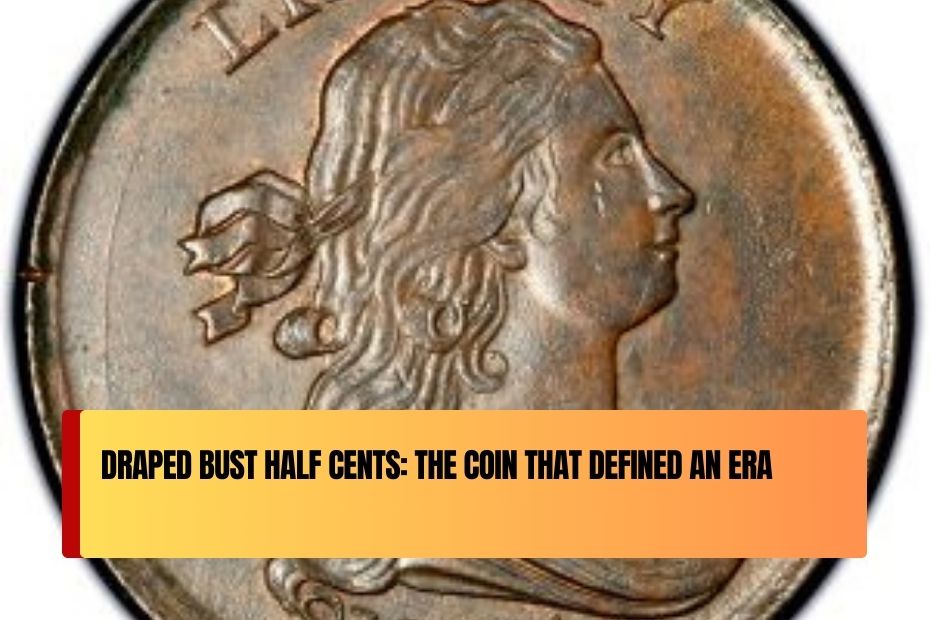The Draped Bust Half Cent is a coin that represents a unique period in American history. Minted between 1800 and 1808, it was one of the earliest coins issued by the United States. This small, copper coin has a rich history, featuring a beautiful design that reflected the values and aspirations of a young nation. In this article, we’ll take a closer look at the history, design, and significance of the Draped Bust Half Cent, helping you understand why this coin continues to capture the interest of collectors and history enthusiasts alike.
History of the Draped Bust Half Cent
The Draped Bust Half Cent was introduced during a critical time in the early years of the United States. In the late 18th century, America was still developing its financial systems, and coins were needed for everyday transactions. The U.S. Mint, which had been established in 1792, began issuing a series of coins, including the Half Cent, to help create a stable currency system for the nation.
The Draped Bust design was chosen because it symbolized liberty, which was a key value for the new country. The coin was first struck in 1800, and it featured the iconic image of Liberty, draped in a flowing gown. These coins circulated widely in the early 19th century and became a common part of American daily life.
The Minting Process
The U.S. Mint produced the Draped Bust Half Cent at the Philadelphia Mint, which was the country’s only minting facility at the time. The coins were made of copper and weighed approximately 5.44 grams. Over the years, the design of the coin changed slightly, but the main features remained the same.
In 1809, the design was updated, and the Draped Bust Half Cent was replaced by the Classic Head design. Although the Draped Bust Half Cent was only produced for a short time, it remains one of the most sought-after coins by collectors due to its rarity and historical significance.
Design of the Draped Bust Half Cent
The design of the Draped Bust Half Cent was created by Robert Scot, the Chief Engraver of the U.S. Mint. The obverse (front) of the coin shows a profile of Liberty, facing left, with her hair flowing and a cloth draped around her shoulders. This gave the coin its name—the Draped Bust. The words “LIBERTY” are inscribed around the top of the coin, and the year of minting is displayed below the bust.
On the reverse side of the coin, there is a wreath made of branches, which symbolizes unity and strength. The words “HALF CENT” are in the center of the wreath, showing the coin’s value. The reverse design emphasizes the importance of agriculture, which was central to the early American economy.
Key Features of the Coin’s Design
| Feature | Details |
|---|---|
| Minting Period | 1800–1808 |
| Designer | Robert Scot |
| Obverse Design | Liberty’s bust with flowing hair, draped gown |
| Reverse Design | Wreath surrounding “HALF CENT” inscription |
| Material | Copper |
| Rarity | Rare, especially in good condition |
| Weight | 5.44 grams |
Significance of the Draped Bust Half Cent
The Draped Bust Half Cent is an important symbol of early America. At the time of its minting, the United States was still developing as a country, and the design of the coin reflected the ideals of liberty and the importance of agriculture. The coin also marked a shift in the country’s coinage system, as the U.S. Mint began producing smaller denominations for use in everyday transactions.
Collectors today value Draped Bust Half Cents not only for their rarity but also for their historical significance. These coins were used by ordinary Americans in the early 19th century, and they represent a key moment in the development of the nation’s economy. The coin’s design, which features Liberty draped in cloth, symbolizes the ideals of freedom and unity that were central to the country’s identity at the time.
Table: Overview of Draped Bust Half Cent
| Feature | Details |
|---|---|
| Minting Period | 1800–1808 |
| Designer | Robert Scot |
| Obverse Design | Liberty’s bust with flowing hair, draped gown |
| Reverse Design | Wreath surrounding “HALF CENT” inscription |
| Material | Copper |
| Weight | 5.44 grams |
| Rarity | Rare, especially in good condition |
| Value Today | Can range from a few hundred to several thousand dollars |
Conclusion
The Draped Bust Half Cent is a coin that not only holds historical value but also serves as a reminder of the early days of the United States. Minted at a time when the country was still defining itself, this coin features a design that symbolizes the core values of freedom, unity, and agricultural strength. Although it was produced for only a short period, the Draped Bust Half Cent remains a beloved piece of American history and a highly sought-after collectible. Whether you are a coin collector or someone interested in early U.S. history, this coin is an important part of the nation’s heritage.
FAQ’s
1. What is the Draped Bust Half Cent?
The Draped Bust Half Cent is a coin minted in the early 19th century, between 1800 and 1808, featuring an image of Liberty on the front and a wreath on the back.
2. Who designed the Draped Bust Half Cent?
The coin was designed by Robert Scot, the Chief Engraver of the U.S. Mint at the time.
3. Why was the Draped Bust Half Cent replaced?
The coin was replaced by the Classic Head design in 1809 as part of changes in U.S. coinage.
4. How much is the Draped Bust Half Cent worth today?
The value of the coin depends on its condition, with prices ranging from a few hundred to several thousand dollars.

